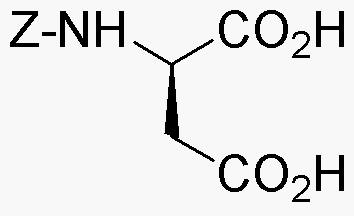Z-D-aspartic acid is widely utilized in research focused on:
- Neuroscience: This compound plays a crucial role in studying neurotransmission and synaptic plasticity, providing insights into memory and learning processes.
- Pharmaceutical Development: It serves as a building block in the synthesis of various pharmaceuticals, particularly those targeting neurological disorders, enhancing drug efficacy.
- Biochemistry: Researchers use it to explore metabolic pathways and enzyme interactions, aiding in the understanding of cellular functions and disease mechanisms.
- Nutrition: Z-D-aspartic acid is studied for its potential benefits in dietary supplements aimed at improving athletic performance and muscle recovery.
- Biotechnology: It is employed in the development of peptide-based therapies, offering advantages in specificity and potency compared to traditional compounds.
General Information
Properties
Safety and Regulations
Applications
Z-D-aspartic acid is widely utilized in research focused on:
- Neuroscience: This compound plays a crucial role in studying neurotransmission and synaptic plasticity, providing insights into memory and learning processes.
- Pharmaceutical Development: It serves as a building block in the synthesis of various pharmaceuticals, particularly those targeting neurological disorders, enhancing drug efficacy.
- Biochemistry: Researchers use it to explore metabolic pathways and enzyme interactions, aiding in the understanding of cellular functions and disease mechanisms.
- Nutrition: Z-D-aspartic acid is studied for its potential benefits in dietary supplements aimed at improving athletic performance and muscle recovery.
- Biotechnology: It is employed in the development of peptide-based therapies, offering advantages in specificity and potency compared to traditional compounds.
Documents
Safety Data Sheets (SDS)
The SDS provides comprehensive safety information on handling, storage, and disposal of the product.
Product Specification (PS)
The PS provides a comprehensive breakdown of the product’s properties, including chemical composition, physical state, purity, and storage requirements. It also details acceptable quality ranges and the product's intended applications.
Certificates of Analysis (COA)
Search for Certificates of Analysis (COA) by entering the products Lot Number. Lot and Batch Numbers can be found on a product’s label following the words ‘Lot’ or ‘Batch’.
*Catalog Number
*Lot Number
Certificates Of Origin (COO)
This COO confirms the country where the product was manufactured, and also details the materials and components used in it and whether it is derived from natural, synthetic, or other specific sources. This certificate may be required for customs, trade, and regulatory compliance.
*Catalog Number
*Lot Number
Safety Data Sheets (SDS)
The SDS provides comprehensive safety information on handling, storage, and disposal of the product.
DownloadProduct Specification (PS)
The PS provides a comprehensive breakdown of the product’s properties, including chemical composition, physical state, purity, and storage requirements. It also details acceptable quality ranges and the product's intended applications.
DownloadCertificates of Analysis (COA)
Search for Certificates of Analysis (COA) by entering the products Lot Number. Lot and Batch Numbers can be found on a product’s label following the words ‘Lot’ or ‘Batch’.
*Catalog Number
*Lot Number
Certificates Of Origin (COO)
This COO confirms the country where the product was manufactured, and also details the materials and components used in it and whether it is derived from natural, synthetic, or other specific sources. This certificate may be required for customs, trade, and regulatory compliance.


